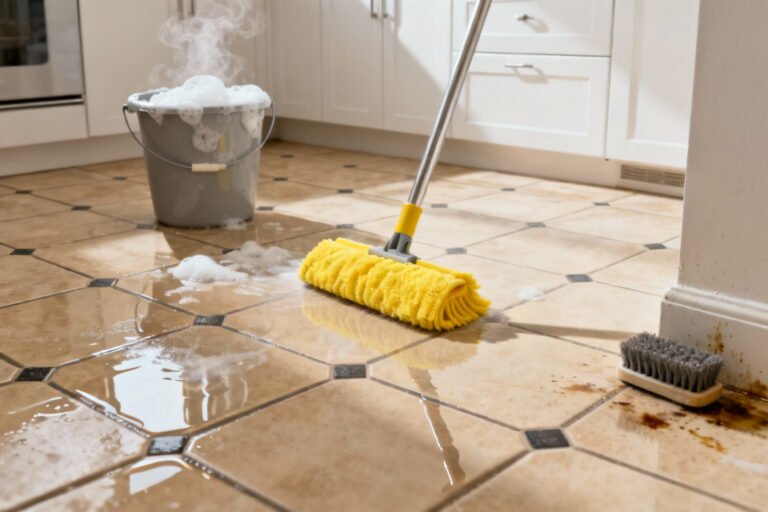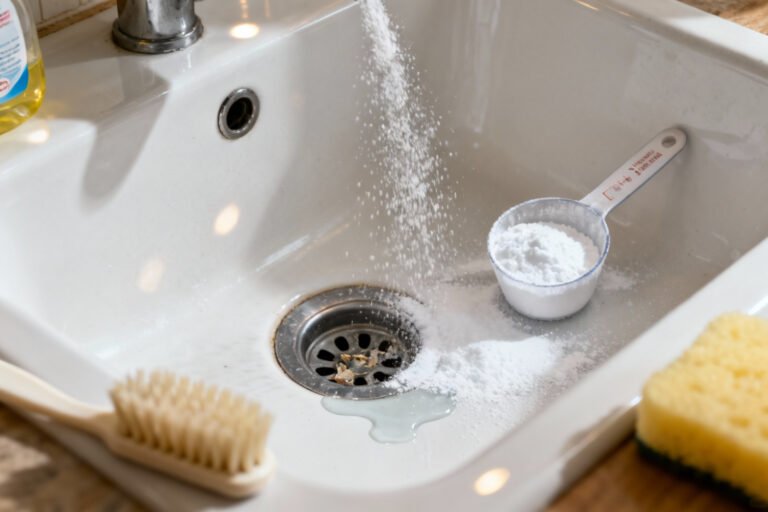Staring at a dirty fabric couch in your living room can be pretty frustrating. We’ve all dealt with those annoying spills, pet messes, or just the regular dirt that builds up over time, making our favorite spot look worn out and uninviting. But before you cover it with a blanket or start shopping for a new one, there are some easy ways to get your sofa looking fresh again.
Some of the links in this article may be affiliate links. If you make a purchase through these links, we may earn a small commission at no extra cost to you. Thank you.
According to Jennifer Parnell, cleaning expert at the American Cleaning Institute, “Regular maintenance is key to keeping fabric furniture looking its best. Most stains can be removed if treated quickly, and weekly vacuuming can prevent dirt from becoming embedded in the fibers.”
Check Cleaning Codes First

The first thing we need to do before tackling any fabric couch cleaning is to check those cleaning codes—they’re absolutely essential to avoid ruining your furniture.
Look for letters like W (water-based cleaners), S (solvents only), or X (just vacuum, no liquids).
I think manufacturers include these for a reason! Regular maintenance and deodorizing techniques can help prevent most odor issues before they arise.
Always test your chosen cleaner in a hidden spot first, even if you’re pretty sure it’s safe.
##
We’ve found that cleaning a fabric couch doesn’t have to be complicated, though there are definitely some important do’s and don’ts to keep in mind.
First, always vacuum thoroughly to remove loose debris before attempting any wet cleaning methods—this prevents dirt from becoming embedded deeper into the fabric when moisture is applied.
When selecting cleaning products, it’s perhaps best to avoid harsh chemicals that might damage the fabric or fade colors, opting instead for gentle, fabric-appropriate solutions that match your couch’s cleaning code. Additionally, always check the cleaning code to determine the appropriate cleaning method for your specific fabric type.
Things to Do When Cleaning A fabric couch
Cleaning a fabric couch requires a systematic approach to effectively remove dirt, odors, and stains while protecting the upholstery.
Starting with proper preparation and using the right cleaning methods guarantees your couch remains fresh and well-maintained without damaging the fabric or underlying structure.
- Check the cleaning code – Look for the manufacturer’s tag to determine the appropriate cleaning method (W for water-based cleaners, S for solvent-based, WS for either, or X for professional cleaning only).
- Vacuum thoroughly – Use upholstery attachments to remove surface dirt, crumbs, pet hair, and debris from all surfaces including crevices and under cushions.
- Treat with baking soda – Sprinkle baking soda liberally across the entire couch, let it sit for at least 30 minutes to absorb odors before vacuuming it up.
- Spot test cleaning solutions – Apply a small amount of your cleaning mixture to an inconspicuous area to make sure it doesn’t cause discoloration or damage.
- Clean removable covers separately – Wash machine-washable covers on a gentle, cold cycle with OxiClean and baking soda for best results.
- Apply cleaning solution sparingly – Dampen rather than soak the fabric when applying DIY cleaners to prevent excessive moisture penetration.
- Dry thoroughly – Allow the couch to air dry completely before using it again to prevent mildew and fabric shrinkage.
Things to Avoid When Cleaning A fabric couch
Cleaning a fabric couch requires careful attention to prevent damaging the upholstery while effectively removing dirt and stains.
Using proper techniques preserves the couch’s appearance and extends its lifespan, while improper cleaning methods can lead to permanent damage, discoloration, or deterioration of the fabric.
- Using solvent-based cleaners – These harsh chemicals can damage fabric fibers, cause discoloration, and break down the material structure of your couch.
- Ignoring the cleaning code – Each fabric couch has a specific cleaning code (W, S, WS, or X) that indicates which cleaning methods are safe; disregarding this can cause irreversible damage.
- Rubbing stains or spills – This pushes the substance deeper into the fabric and spreads the stain; always blot gently instead.
- Oversaturating the fabric – Excessive moisture can lead to water damage, mold growth, fabric shrinkage, or wrinkling if not dried properly.
- Skipping the spot test – Always test cleaning solutions on an inconspicuous area first to make sure they won’t cause discoloration or damage to your specific fabric type.
Steps
Cleaning a fabric couch requires methodical attention to restore its appearance and eliminate odors.
A thorough cleaning not only removes visible dirt but also addresses embedded allergens and bacteria that can accumulate over time.
By following these simple yet effective techniques, you can rejuvenate your fabric sofa without the expense of professional cleaning services.
Step 1: Remove cushion covers if possible and shake them outdoors to dislodge loose debris and dust.
Step 2: Wash removable covers on a cold, gentle cycle with OxiClean and baking soda, then line dry to prevent shrinkage.
Step 3: Vacuum the entire couch thoroughly using an upholstery attachment to remove hair, crumbs, and surface dirt.
Step 4: Sprinkle baking soda generously over all fabric surfaces and let it sit for 30 minutes to absorb odors.
Step 5: Vacuum up all the baking soda completely, making sure no residue remains.
Step 6: Prepare a DIY cleaning solution with water and mild detergent in a spray bottle.
Step 7: Test the solution on an inconspicuous area to make sure it doesn’t damage or discolor the fabric.
Step 8: Spray the solution lightly until the fabric is damp but not soaked.
Step 9: Wipe the dampened areas with a clean, dry microfiber cloth using circular motions.
Step 10: Allow the couch to air dry completely before replacing cushions and using the furniture.
Final Thoughts
After completing each step in our cleaning process, you’ll notice your fabric couch transformed from a tired, dingy piece to a refreshed focal point in your living space.
We’ve found that committing to deep cleaning once or twice yearly truly makes a difference.
Perhaps it’s the combination of regular maintenance and proper drying that keeps our own sofas looking newer longer.
##

Cleaning your fabric couch doesn’t have to be an overwhelming task.
By implementing regular vacuuming monthly and scheduling deeper cleanings twice a year in spring and fall, you can greatly extend your sofa’s lifespan while keeping it looking fresh and inviting.
Remember that the key to maintaining your couch’s appearance lies in quick action on spills, consistent maintenance, and allowing proper drying time after cleaning to preserve the fabric’s shape and prevent unwanted wrinkles.
Your newly cleaned couch will reward you with a brighter, fluffier appearance that transforms your living space. This is especially important for those high-traffic areas like sofa arms that tend to show wear first.
Whether you have pets, children, or simply enjoy entertaining guests, these cleaning techniques will help your fabric couch remain a comfortable centerpiece in your home for years to come.
Take the first step today by gathering your cleaning supplies and giving your couch the attention it deserves.
Regular cleaning also prevents the buildup of allergens and dust mites that can affect your health.
Your future self will thank you when you’re relaxing on a clean, fresh-smelling sofa that still looks as good as the day you bought it.






